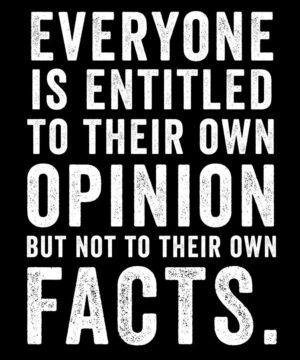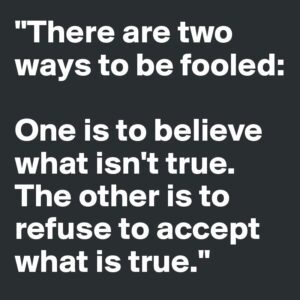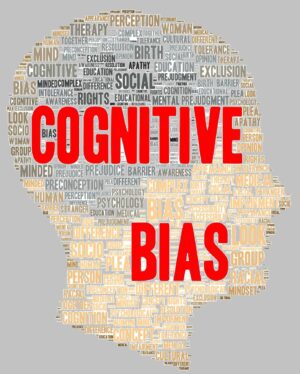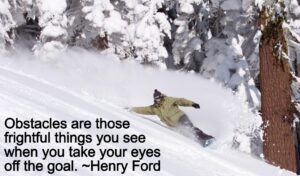Podcast: Play in new window | Download
 You’ve heard it said that, ‘Every person is entitled to their own opinion, but not to their own facts.‘ Yet we routinely craft our own facts from the fabric of personal experiences, preferences and prejudices.
You’ve heard it said that, ‘Every person is entitled to their own opinion, but not to their own facts.‘ Yet we routinely craft our own facts from the fabric of personal experiences, preferences and prejudices.
A stereotype is nothing more than a pattern we’ve observed.
This pattern isn’t always predictive, but it is a pattern nonetheless and we trust it. We do this in the misbegotten belief that we have correctly interpreted our past experiences and that our preferences and prejudices are, in fact, correct and reliable interpretations of objective reality. We’re a funny, funny species, aren’t we? (~Roy Williams)
 Your ‘floor’, the floor you’ve been living on, that solid foundation for all your thinking, all your actions is built of opinions, not facts…
Your ‘floor’, the floor you’ve been living on, that solid foundation for all your thinking, all your actions is built of opinions, not facts…
Opinions, of just something that you said… or somebody else said… but not facts.
The mind wants to turn everything into a rule, and it has. All those rules make up your floor.
But why? Why would the mind turn everything to a rule?
Because, in general, there is so much to think about, so much to pay attention to… It is NATURAL for a living being to find shortcuts.
But to live life with shortcuts that you never examine is called cognitive bias: behaving as if they were true is called cognitive bias.
 Cognitive biases are unconscious errors in thinking that arise from problems related to memory, attention, and other mental mistakes.
Cognitive biases are unconscious errors in thinking that arise from problems related to memory, attention, and other mental mistakes.- These biases result from our brain’s efforts to simplify the incredibly complex world in which we live.
- Confirmation bias, hindsight bias, self-serving bias, anchoring bias, availability bias, the framing effect, and inattentional blindness are some of the most common examples of cognitive bias. Another example is the false consensus effect.
- Cognitive biases have direct implications on our safety, our interactions with others, and the way we make judgments and decisions in our daily lives.
- Although these biases are unconscious, there are small steps we can take to train our minds to adopt a new pattern of thinking and mitigate the effects of these biases.
Another large group of ‘rules’ come from religion. Every religion wants to codify behavior. And they use the infallible deity as the authority who says it’s a rule.
I am not familiar with many religious dogmas… (hey, I almost forgot about the dogmas!) but I have some second hand experience with Christianity: don’t do, don’t be, don’t don’t don’t… it’s a sin! You’ll go to hell!!! And even when you admit you did that, the reparation the deity asks for is praying, shame, regret… not some good constructive action.
When your eyes are always on what not to do, what is harmful, what is bad… you can never get ahead in life.
 Suddenly the poster someone gave me a few decades ago makes sense. Henry Ford said: Obstacles are those frightful things you see when you take your eyes off your goal. (remember the winding mountain road story I love?)
Suddenly the poster someone gave me a few decades ago makes sense. Henry Ford said: Obstacles are those frightful things you see when you take your eyes off your goal. (remember the winding mountain road story I love?)
But it would apply to more people to say:
When all you see are the obstacles, the hard, the difficult, the impossible, the immoral, the painful, you’ll never get anywhere… you languish. Take your eyes of those… they are probably not real anyways.
Neither the things you say about yourself, or about the world are actually and factually true.
My students’ average truth value in what they say in their heads and what they use to guide their actions is around 1%. So you can be quite reasonable to abandon all the fear and all the trepidation, and all caution and just do what you need to do to get what you want.
In educated society (tongue in cheek!) people who keep their eyes on the obstacles are considered cowardly. And they are…
Notice that what is guiding behavior is what you see… And before you would see you look… And that is where cowardice comes in. In the looking.
The other group of people, depending on where they look and therefore what they see are the conceited group (as opposed to the cowardly group) and all they can see is that they are deserving, special, slighted, and guess what: they don’t do much either. They expect the things they want to drop on their laps… without work.
The most obviously harmful is the combination of the two: the cowardly-conceited ones… They never do anything.
That is 70% of all humanity.
So, in essence, 30% of humanity COULD do something… and yet they don’t… or most of them don’t.
What do I mean by ‘do something’?
I mean do something constructive to better their life, to get ahead, for themselves.
All religions HATE and speak against personal power. They don’t want people to have any power… So they talk against being selfish… Wanting and doing anything for yourself is considered by all religions, and all authorities a sin.
While Life wants you to be selfish. Not at the expense of others…
One of the things you can notice in all rule-like statements is vagueness. They don’t specify what they mean…
It took till the 20th Century to finally distinguish what is the definition of good… And hundreds of philosophers of all ages had tried before.
Good is that which completely fulfills its purpose purpose and character.
So all the ways Christianity defines bad aka sins is completely off…
If a human is good if it fulfills its purpose then the next question is: what is a human’s purpose and also what is the concept: human.
We have seen that being an invasive species doesn’t quite fulfill the purpose of human: destroying the planet you live on… doesn’t sound like the purpose of humanity, does it?
As you can see… we, humans, live with a completely made up world that is like a maze: bad bad good good… And those who are real bad ignore everything and do whatever they want… say whatever they want… and get away with it.
One of my favorite episodes of the Borowitz Report titled: Trump suggests that Putin should just claim he won.
I should be really grateful to Trump for going all the way to the edge of what humans live by… made up stuff… Not even a glimpse of reality, because they don’t even look.
Back to looking…
Looking is an action. There are many aspects in fact that looking can be defined.
- Who is looking… what is the attitude, what is the agenda of the person who is looking.
- How the person who is looking is looking… hurriedly, with an eagerness to find, or slowly, allow the yet invisible to reveal itself
- Where exactly is the glance directed? At what you already know seeking confirmation, or wider to see connections and bigger picture
- Look around to be able to locate oneself… to see exactly the vantage point
- Look inward to see what is the hidden agenda, the hidden commitment, the fear and the greed, the evil
And these, although they only scratch the surface of looking are about 20 times richer than the average man considers when they say they are looking.
We could use looking as a useful filter to look through when we look at filter. We would look at all those aspects I listed and surprisingly we would see what kind of person we are dealing with.
How you do anything is how you do everything, and therefore observation and knowing what you see if the main key to emotional intelligence…
Intellectual intelligence is important. But with low emotional intelligence, and most of life involves people, if none other but ourselves, emotional intelligence is actually more important than intellectual intelligence when you want to have a good life.
The world’s intellectual intelligence, considering 2015’s number as the baseline at 100, is now 70.
Why 2015?
It was in 2015 when I started to measure intelligence, that’s why.
The world’s emotional intelligence in 2015 was 70. Lower than the intellectual intelligence. Today the world’s emotional intelligence is 30 and that number is still falling.
Why? Because we see facial expressions, videos, etc. separated from context… and we see too many on the internet. So we have become blind to them, including ourselves.
The Moneyroots workshop does what you normally cannot do while living the life you live. You need to take time out to examine the ‘floor’ you consider reality. And it is near impossible to be able to see it while you are living… your day to day life.
And to boot, it is near impossible to see it at all… It is like you are trying to see the back of your head… Unless someone holds up a mirror to it so you can see it.
In the Moneyroots workshop that is exactly what we do: hold up a mirror so you can see what you haven’t been able to see.
Whether you make changes in your life or not… that is not part of this workshop.
I know, every other teacher would go straight to how to get better results… but they miss attending to the roots. They also miss that the chances that you want to be fooled is high. Very high.
In my workshops you are confronted with that… and then left to your own intellectual faculties to make a decision if you want to continue to be fooled. You may, and that is OK with me.
It is your life…
PS: The world’s vibration is falling rapidly as well. Unless your vibration was at least 200 in 2015, it has fallen by a lot.
The average vibration now is 70… It was 120 in 2015.
